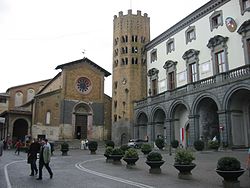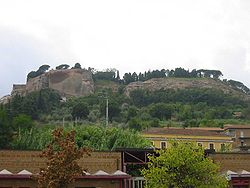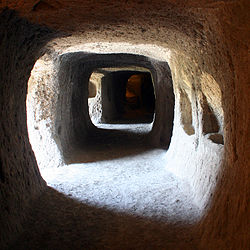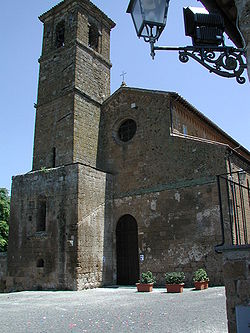- Orvieto
-
For the wine, see Orvieto (wine).
Orvieto — Comune — Città di Orvieto Piazza della Repubblica. 
Coat of armsLocation of Orvieto in Italy Coordinates: 42°43′N 12°06′E / 42.717°N 12.1°ECoordinates: 42°43′N 12°06′E / 42.717°N 12.1°E Country Italy Region Umbria Province Terni (TR) Frazioni Bagni di Orvieto, Bardano, Baschi Scalo, Benano, Biagio, Botto di Orvieto, Canale di Orvieto, Canonica, Capretta, Ciconia, Colonnetta di Prodo, Corbara, Fossatello, Morrano, Orvieto Scalo, Osteria Nuova, Padella, Prodo, Rocca Ripesena, San Faustino, Sferracavallo, Stazione di Castiglione, Sugano, Titignano, Tordimonte, Torre San Severo Government – Mayor Toni Còncina Area – Total 281 km2 (108.5 sq mi) Elevation 325 m (1,066 ft) Population (May 31, 2008) – Total 21,043 – Density 74.9/km2 (194/sq mi) Demonym Orvietani Time zone CET (UTC+1) – Summer (DST) CEST (UTC+2) Postal code 05018 Dialing code 0763 Patron saint St. Joseph Saint day March 19 Website Official website Orvieto is a city and comune in Province of Terni, southwestern Umbria, Italy situated on the flat summit of a large butte of volcanic tuff. The site of the city is among the most dramatic in Europe, rising above the almost-vertical faces of tuff cliffs that are completed by defensive walls built of the same stone called Tufa.
Contents
History
Etruscan era
The ancient city (urbs vetus in Latin, whence "Orvieto"), populated since Etruscan times, has usually been associated with Etruscan Velzna, but some modern scholars differ. Orvieto was certainly a major centre of Etruscan civilization; the Archaeological Museum (Museo Claudio Faina e Museo Civico) houses some of the Etruscan artifacts that have been recovered in the immediate neighbourhood. An interesting survival that might show the complexity of ethnic relations in ancient Italy and how such relations could be peaceful, is the inscription on a tomb in the Orvieto Cannicella necropolis: mi aviles katacinas, "I am of Avile Katacina", with an Etruscan-Latin first name (Aulus) and a family name that is believed to be of Celtic ("Catacos") origin.
Roman and post-Roman eras
Orvieto was annexed by Rome in the third century BC. After the collapse of the Roman Empire its defensible site gained new importance: the episcopal seat was transferred from Bolsena, and the city was held by Goths and by Lombards before its self-governing commune was established in the 10th century, in which consuls governed under a feudal oath of fealty to the bishop. Orvieto's relationship to the papacy has been a close one; in the tenth century Pope Benedict VII visited the city of Orvieto with his nephew, Filippo Alberici, who later settled there and became Consul of the city-state in 1016.
Middle Ages
Orvieto, sitting on its impregnable rock controlling the road between Florence and Rome where it crossed the Chiana, was a large town: its population numbered about 30,000 at the end of the 13th century.[1] Its municipal institutions already recognized in a papal bull of 1157,[2] from 1201 Orvieto governed itself through a podestà, who was as often as not the bishop, however, acting in concert with a military governor, the "captain of the people". In the 13th century bitter feuds divided the city, which was at the apogee of its wealth but found itself often at odds with the Papacy, even under interdict. Pope Urban IV stayed at Orvieto in 1262-1264.
Some of the families traditionally associated with major roles in Orvieto’s history are: Monaldeschi, Filippeschi, Alberici and Gualterio, of whom only the Alberici and the Gualterio have survived to the present day. The city became one of the major cultural attractions of its time when Thomas Aquinas taught at the Studium. A small university (now part of the University of Perugia), had its origins in a studium generale that was granted to the city by Pope Gregory XI in 1736.
Papal rule
The territory of Orvieto was under papal control long before it was officially added to the Papal States (various dates are quoted); it remained a papal possession until 1860, when it was annexed to newly unified Italy.
Main sights
The Duomo
Main article: Orvieto CathedralOn November 15, 1290, Pope Nicholas IV laid the cornerstone for the present building and dedicated it to the Assumption of the Virgin, a feast for which the city had a long history of special devotion. The design has often been attributed to Arnolfo di Cambio, but the prevailing modern opinion is that its master mason was an obscure monk named Fra' Bevignate from Perugia. The church is striped in white travertine and greenish-black basalt in narrow bands, similar in many ways to the cathedral of Siena and other central Italian cathedrals of that era. In the following decade, cathedral authorities called Sienese architect and sculptor Lorenzo Maitani to stabilize the building and design a façade. He enlarged the choir and planned a transept with two chapels (c.1308-1330), spaces that were not finished until long after his death. The façade (illustration, right) is particularly striking and includes some remarkable sculpture by Lorenzo Maitani (14th century). Inside the cathedral, the Chapel of San Brizio is frescoed by Fra Angelico and with Luca Signorelli's masterpiece, his Last Judgment (1449–51). On the left side of this chapel are the tombs of the Gualterio family.
The Corporal of Bolsena, on view in The Duomo, dates from a Eucharistic miracle in Bolsena, Italy in 1263 when a consecrated host began to bleed onto a corporal, the small cloth upon which the host and chalice rest during the Canon of the Mass.
Papal residence
Main article: Orvieto PapacyFrom the 11th century onward, the pope maintained an aggressive political presence in the papal territory, which occupied central Italy. Together with his court, the pope moved from palace to palace in the manner of his European secular counterparts. Several central Italian cities hosted the pope and his retinue during the years of wandering, housing them in the bishop's palace. Outside Rome, only Orvieto and Viterbo (and eventually Avignon) had papal palaces. Adrian IV (1154–59) was the first pope to spend significant time in Orvieto. His successor, Innocent III (1198–1216), was a militant opponent of the Cathar heresy, which had infiltrated the city, and took measures to eradicate that heresy. In 1227, Pope Gregory IX confirmed the Dominican studium generale in Orvieto, a school of theology, and one of the first in Europe. Pope Urban IV (1261–64), a Frenchman who was crowned in the Dominican church in Viterbo and who spent most of his papacy in Orvieto, also left important legacies in the city. In 1263, he began a papal palace, perhaps the first outside Rome, and consecrated the new Dominican Church in Orvieto. Pope Nicholas IV (1288–92) chose Orvieto over his hometown of Rome as seat of the Curia in 1291-92, establishing the meeting of the Curia in Orvieto as a tradition. He was rewarded by the Orvietans by being elected Podestà and Capitano del Popolo, the first pope to hold civic offices in the city.
His successor Boniface VIII (1294–1303) continued the papal tie to Orvieto. Although often criticized by historians for nepotism and greed, the Orvietans were recipients of the pope's generosity, and honored Boniface by electing him city Capitano and Podestà in 1297 and Capitano again in 1298. He built the third and final Palazzo Papale, Palazzo Soliano. He also donated statues of himself at the main city gates, which earned him some criticism from his many enemies. Benedict XI (1288–1305) was the last pope to live in Italy before the Avignon papacy. During the years from Nicholas IV until Benedict XI Orvieto hosted the pope more frequently than Rome, and discussions continued as to whether or not Rome should remain the papal city. Pope Nicholas V (1447–55) gave support to the city. In a letter of 1449, the pope gave money for the restoration of the Episcopal Palace that originally had been a project of Nicholas IV. He also allowed Fra Angelico to begin painting in the Cappella Nuova of the Cathedral.
During the sack of Rome in 1527 by the Holy Roman Emperor Charles V, Pope Clement VII took refuge at Orvieto. Fearing that in the event of siege by Charles' troops the city's water might prove insufficient, he had a spectacular well (the Pozzo di S. Patrizio or "Well of St. Patrick", so called because this Italian expression, inspired by medieval legends that St. Patrick's Purgatory in Ireland gave access down to Purgatory, is used to indicate something very deep) constructed by the architect-engineer Antonio da Sangallo the Younger. The central well shaft was surrounded by ramps in a double helix. These ramps were each designed for one-way traffic, so that mules laden with water-jars might pass down then up again unobstructed. An inscription on the well boasts that QUOD NATURA MUNIMENTO INVIDERAT INDUSTRIA ADIECIT ("what nature stinted for provision, application has supplied").
Underground city
The city of Orvieto has long kept the secret of its labyrinth of caves and tunnels that lie beneath the surface. Dug deep into the tuff, a volcanic rock, these hidden and secret tunnels are only now open to view through guided tours. Their spectacular nature has also yielded many historical and archeological finds. Saint Anselm College in New Hampshire, the United States, has set up a program, where each summer, students travel to Italy to work at the college’s archaeology site located at the Coriglia excavation site, just outside of town.[3]
The underground city boasts tunnels, galleries, wells, stairs, quarries, cellars, unexpected passageways, cisterns, superimposed rooms with numerous small square niches, detailing its creation over the centuries. Many of the homes of noble families were equipped with a means of escape from the elevated city during times of siege through secret escape tunnels carved from the soft rock. The tunnels would lead from the city palazzo to emerge at a safe exit point some distance away from city walls.
Palazzo del Capitano del Popolo
Work on the construction of the Palazzo del Capitano del Popolo began in the 13th century on an area that had been occupied since 1157 by the Papal Palace built under the reign of Pope Hadrian IV.
The original Palazzo del Capitano was a single ground floor loggia that was used as a market place or for meetings, from which the magistrate would speak to the citizens. This was where the surrounding lords or representatives of vanquished cities came to pay their allegiance to Orvieto.
The structure was enlarged within ten years of it having been completed and in 1315 the bell tower was added and in the subsequent year a great bell was hung there. The upper part of the structure was covered in 1472 and the large hall divided into two rooms, one large and the other small. The larger of the two occupied an area that corresponds approximately to the room known today as the Sala dei Quattrocento. Subsequently, the building functioned as a residence for the Capitano del Popolo, the Podestà and the Signori Sette.
From 1596 one of the lower section rooms housed the Studium, which had been re-instituted a few years earlier by Lorenzo Magalotti. Students of law, theology and logic came here to study twice a day, each time the bell of Palazzo del Popolo rung, until 1651. Few records exist of this ancient university appear after this date. Some sources indicate that it dates back to 1013 and had connections with names such as the Benedictine monks Graziano and Gozio of Orvieto.
The Albornoz Fortress
In Piazza Cahen stands the Fortezza dell'Albornoz. It was built by order of the Spanish Cardinal Albornoz under orders from Pope Innocent VI and designed by condottiero and military engineer Ugolino di Montemarte. The Albornoz fortress stands on an area that was once occupied by a temple, known by the Etruscan name of Augurale.
Originally known as the Rocca di San Martino, construction on this massive fortress started either in 1359 or 1353 near the town’s cemetery. Its aim was to allow the Church a secure site in the city and allowing the Cardinal and his captains to consolidate their recent military victories.
In its original square plan the fortress was flanked by a small building near the main entrance and surrounded by a moat, which was only accessible by the drawbridge. However, the Rocca was almost completely razed to the ground in 1395 and successive attempts to rebuild it were unsuccessful. The fortress was finally rebuilt during the mid-15th century using original plans and an additional circular line of fortifications.
After the Sack of Rome at the end of 1527 Pope Clement VII took refuge in Orvieto. To ensure that the city would be sufficiently supplied with water in the event of a siege, he gave orders for the digging of the now famous artesian well Pozzo di San Patrizio (1528–1537). For added security, the pope ordered that a second well be dug to supply the fortress alone.
Others
- San Giovenale, built in 1004, probably over a preexisting church, is the oldest church in Orvieto. Contains many 13th century frescos.[4]
- San Domenico, one of the first Dominican churches.
- Orvieto is also home to Etruscan ruins and the remnants of a wall that enclosed the city more than 2000 years ago. At the foot of the butte, surrounded by peach and apple trees and a vineyard, the Etruscan necropolis of Crocefisso di Tufo counts a hundred or so chamber tombs laid along a rectangular street grid.
Economy
Main article: Orvieto (wine)The white wine of the Orvieto district, to the northeast of the city, is highly prized; red wines are also grown.
Orvieto is a member of Cittaslow, the slow food movement.
Twin towns - Sister cities
See also: List of twin towns and sister cities in ItalyOrvieto is twinned with:
 Bethlehem, Palestinian Authority [5]
Bethlehem, Palestinian Authority [5] Givors, France
Givors, France Maebashi, Japan
Maebashi, Japan Aiken, United States
Aiken, United States Seinäjoki, Finland
Seinäjoki, Finland Kercem, Malta
Kercem, Malta Avignon, France
Avignon, France
Notes
- ^ G. Pardi, Il catasto d'Orvieto dell'anno 1292 (Perugia 1896) noted in D. P. Waley, "Pope Boniface VIII and the Commune of Orvieto" Transactions of the Royal Historical Society, Fourth Series, 32 (1950:121-139) p. 121 note 2.
- ^ Codice diplomatico della città d'Orvieto (Florence 1884:26).
- ^ http://blogs.saintanselmcollege.net/2009/10/01/caitlin-mcgee10-travels-to-italy-third-time-around-with-research-grant/
- ^ Korn, Frank J. (2002). Hidden Rome. Mahwah, N.J.: Paulist Press. pp. 210. ISBN 9780809141098. http://books.google.co.uk/books?id=RV_gyKqm7REC&pg=PA210&dq=%22San+Giovenale%22+1004.
- ^ "::Bethlehem Municipality::". www.bethlehem-city.org. http://www.bethlehem-city.org/Twining.php. Retrieved 2009-10-10.
External links
- Official Site
- Orvieto (Thayer's Gazetteer of Umbria)
- Duomo of Orvieto (InItaly.Com)
- (Soprintendenza per i Beni Archeologici dell' Umbria) National Archaeological Museum of Orvieto. Located in the Palazzo Papale.
- Different views of Orvieto (Adventures In Italy)
- Orvieto events and attractions Useful updated information and what to see.
Umbria · Comuni of the Province of Terni Acquasparta · Allerona · Alviano · Amelia · Arrone · Attigliano · Avigliano Umbro · Baschi · Calvi dell'Umbria · Castel Giorgio · Castel Viscardo · Fabro · Ferentillo · Ficulle · Giove · Guardea · Lugnano in Teverina · Montecastrilli · Montecchio · Montefranco · Montegabbione · Monteleone d'Orvieto · Narni · Orvieto · Otricoli · Parrano · Penna in Teverina · Polino · Porano · San Gemini · San Venanzo · Stroncone · TerniCategories:- Cities and towns in Umbria
- Communes of the Province of Terni
- Hilltowns in Italy
- Cittaslow
- Hilltowns in Umbria
- Wine regions of Italy
- Volcanoes of Italy
- Volcanic plugs of Italy
- Castles in Italy
Wikimedia Foundation. 2010.









